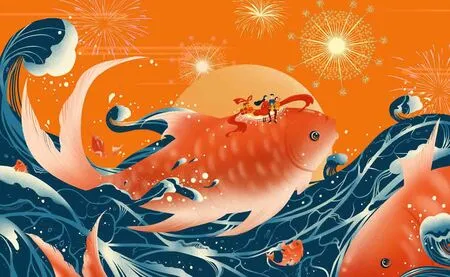锦
2021-05-14

When Chinese President Xi Jinping delivered a New Year speech in Beijing to ring in 2021,he sincerely wished our land glory,our country prosperity,and our people peaceful lives.(惟愿山河锦绣、国泰民安! wéi yuàn shānhé jǐnxiù,guó tài mín ān!)
In her bid for San Francisco District Attorney,newly elected Vice President,Kamala Harris,gave herself a Chinese name 贺锦丽(Hè Jǐnlì) to attract the Asian vote.The name translates literally as “elegant and beautiful.” Now,why is this character 锦so widely favored by both Chinese and Non-Chinese alike? Read on.
The culturally rich Chinese character 锦boasts a long history that can be traced back to the Warring States Period (475-221 BC).As recorded in the etymology dictionaryShuowen Jiezi(《说文解字》),“锦,襄邑织文” (jǐn,xiāng yì zhī wén) indicates that it was a brightly colored brocade hand woven in the Xiangyi area.
In terms of its structure,锦is a pictophonetic character composed of two functional components,the radical on the left 钅(jīn),meaning gold,gives the sound (jǐn).Gold was once regarded as the world’s most precious substance and was used as currency in ancient times.The component on the right consists of白(baí) and 巾 (jīn).白,meaning white,was a highly prevalent color in ancient Chinese society closely related to concepts like frost,snow,purity,bright,and clear.巾 refers to silk fabric and denotes the meaning of the multicolored silk fabrics.The two components combine to create a single meaning,“Multi-colored fabric with gold and color sewn in.” When used as an adjective,it means,“brightly colored,elegant and magnificent.”
In ancient China,weaving a brocade was not easy.Generally,the weaving involved cooperation between two weavers.One sat on the top of the loom and lifted one end of a thread,and the other,seated in front of the loom,wove the thread into the brocade.The weavers decided which thread was to be lifted up and woven in according to a pre-set pattern,resulting in an exquisite brocade known for its lustrous sheen,rich colors and refined design.Hence,the close relationship that 锦 has with color.
Even today traditional weaving cannot be replaced by modern machines.Scientists and experts alike are mystified when utilizing sophisticated computer programs.In ancient times,it took years to create just one large piece,which is why silk fabrics with bright colors were so precious in ancient dynasties.Only the wealthy ruling classes could afford the fabric,which was often encrusted with jewels and embroidery.
Many regions developed their own signature weaving skills and craftsmanship.The most renowned brocades are from the Song Dynasty (宋锦sòng jǐn),the Shu brocade (蜀锦shǔjǐn,produced in Sichuan Province),Yun brocade (云锦yúnjǐn,produced mainly in Nanjing,capital city of Jiangsu Province)and Zhuang brocade (壮锦zhuàngjǐn,embroidered by the Zhuang people),which are listed in China National Intangible Cultural Heritage.Due to the complexity of the brocade production process,it takes a lot of time and effort to produce and brocade.In Shu brocade-weaving traditions,the most skilled workers can only weave at most a few centimeters per day,and it takes years to master the technique.This spirit of “focusing on work and striving for excellence” is the spirit of craftsmanship,and is the spirit that is revered in Chinese society.
Labeled as a beautiful item and a bright color,the character锦 is often seen in daily life as well as in literature.For instance,inThe Book of Poems,the first collection of Chinese poetry,“锦衣狐裘”(jǐn yī hú qiú) meant a bright cloak made of fox fur.“The Story of Yueyang Tower”(《岳阳楼记》)composed by Song Dynasty poet and politician Fan Zhongyan(范仲淹) features exquisite passages,such as “沙鸥翔集,锦鳞游泳” (shā ōu xiáng jí,jǐn lín yóu yǒng).Here,“锦鳞” refers to the brightly colored fish,expressing good wishes for the homeland.Interestingly,the character 锦 was also used in written correspondence (锦素 jǐn sù) or a salutation in letters like 锦念(jǐn niàn) or 锦注(jǐn zhù),with a meaning similar to “thou” in English.
Because of its positive imagery and connotations,锦 is present in many Chinese idioms.For example,衣锦还乡 (yī jǐn huán xiāng) means one is successful and returns home in sublime clothing.锦上添花 (jǐn shàng tiān huā)matches the English idiom,“icing on the cake.” 锦囊妙计 (jǐnnáng miàojì) suggests a secret master plan,and 锦衣玉食 (jǐn yī yù shí)describes a kind of extravagant life.Curiously,the word“tournament” is translated into 锦标赛 (jǐnbiáosài) in Chinese,but why? In ancient times,an athlete was awarded an embroidered banner when winning.
Since the word 锦 indicates preciousness and magnificence,the Chinese people are inclined to use it to express their good wishes.You can see embroidered sachets 锦囊(jǐnnáng) during the Dragon Boat Festival,as the sachet symbolizes the pursuit of a healthy and beautiful life.Many wedding dresses and mandarin duck quilts also use silk brocade as tokens of hope,happiness,and prosperity.In recent years,Chinese netizens’craze for the legendary Koi fish 锦鲤(jǐn lǐ).Traditionally a symbol of good luck in Asia,the Koi Fish has driven millions of Chinese youngsters to repost Koi-related tweets in the hopes of attaining wealth and better health.

Shu brocade produced in Chengdu成都蜀锦织品
